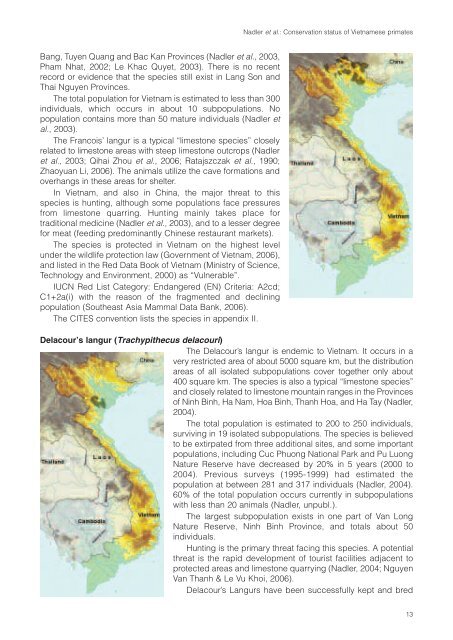Vietnamese Journal of Primatology - Frankfurt Zoological Society
Vietnamese Journal of Primatology - Frankfurt Zoological Society
Vietnamese Journal of Primatology - Frankfurt Zoological Society
Create successful ePaper yourself
Turn your PDF publications into a flip-book with our unique Google optimized e-Paper software.
Bang, Tuyen Quang and Bac Kan Provinces (Nadler et al., 2003,<br />
Pham Nhat, 2002; Le Khac Quyet, 2003). There is no recent<br />
record or evidence that the species still exist in Lang Son and<br />
Thai Nguyen Provinces.<br />
The total population for Vietnam is estimated to less than 300<br />
individuals, which occurs in about 10 subpopulations. No<br />
population contains more than 50 mature individuals (Nadler et<br />
al., 2003).<br />
The Francois’ langur is a typical “limestone species” closely<br />
related to limestone areas with steep limestone outcrops (Nadler<br />
et al., 2003; Qihai Zhou et al., 2006; Ratajszczak et al., 1990;<br />
Zhaoyuan Li, 2006). The animals utilize the cave formations and<br />
overhangs in these areas for shelter.<br />
In Vietnam, and also in China, the major threat to this<br />
species is hunting, although some populations face pressures<br />
from limestone quarring. Hunting mainly takes place for<br />
traditional medicine (Nadler et al., 2003), and to a lesser degree<br />
for meat (feeding predominantly Chinese restaurant markets).<br />
The species is protected in Vietnam on the highest level<br />
under the wildlife protection law (Government <strong>of</strong> Vietnam, 2006),<br />
and listed in the Red Data Book <strong>of</strong> Vietnam (Ministry <strong>of</strong> Science,<br />
Technology and Environment, 2000) as “Vulnerable”.<br />
IUCN Red List Category: Endangered (EN) Criteria: A2cd;<br />
C1+2a(i) with the reason <strong>of</strong> the fragmented and declining<br />
population (Southeast Asia Mammal Data Bank, 2006).<br />
The CITES convention lists the species in appendix II.<br />
Nadler et al.: Conservation status <strong>of</strong> <strong>Vietnamese</strong> primates<br />
Delacour’s langur (Trachypithecus delacouri)<br />
The Delacour’s langur is endemic to Vietnam. It occurs in a<br />
very restricted area <strong>of</strong> about 5000 square km, but the distribution<br />
areas <strong>of</strong> all isolated subpopulations cover together only about<br />
400 square km. The species is also a typical “limestone species”<br />
and closely related to limestone mountain ranges in the Provinces<br />
<strong>of</strong> Ninh Binh, Ha Nam, Hoa Binh, Thanh Hoa, and Ha Tay (Nadler,<br />
2004).<br />
The total population is estimated to 200 to 250 individuals,<br />
surviving in 19 isolated subpopulations. The species is believed<br />
to be extirpated from three additional sites, and some important<br />
populations, including Cuc Phuong National Park and Pu Luong<br />
Nature Reserve have decreased by 20% in 5 years (2000 to<br />
2004). Previous surveys (1995-1999) had estimated the<br />
population at between 281 and 317 individuals (Nadler, 2004).<br />
60% <strong>of</strong> the total population occurs currently in subpopulations<br />
with less than 20 animals (Nadler, unpubl.).<br />
The largest subpopulation exists in one part <strong>of</strong> Van Long<br />
Nature Reserve, Ninh Binh Province, and totals about 50<br />
individuals.<br />
Hunting is the primary threat facing this species. A potential<br />
threat is the rapid development <strong>of</strong> tourist facilities adjacent to<br />
protected areas and limestone quarrying (Nadler, 2004; Nguyen<br />
Van Thanh & Le Vu Khoi, 2006).<br />
Delacour’s Langurs have been successfully kept and bred<br />
13
















